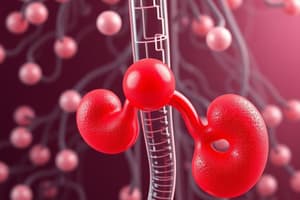Podcast
Questions and Answers
Which diuretic class primarily inhibits carbonic anhydrase in the proximal tubule?
Which diuretic class primarily inhibits carbonic anhydrase in the proximal tubule?
- Carbonic anhydrase inhibitors (correct)
- Osmotic diuretics
- Thiazide diuretics
- Loop diuretics
What is the primary site of action for thiazide diuretics?
What is the primary site of action for thiazide diuretics?
- Proximal tubule
- Collecting tubule
- Distal convoluted tubule (correct)
- Loop of Henle
Which diuretic class is typically classified as potassium-sparing?
Which diuretic class is typically classified as potassium-sparing?
- Loop diuretics
- Aldosterone antagonists (correct)
- Osmotic diuretics
- Thiazides
What is a potential side effect of NSAIDs on kidney function?
What is a potential side effect of NSAIDs on kidney function?
Which hormonal system is targeted by drugs that influence renal function?
Which hormonal system is targeted by drugs that influence renal function?
Which mechanism is primarily associated with loop diuretics?
Which mechanism is primarily associated with loop diuretics?
What role do pharmacologic agents that stimulate mitochondrial biogenesis play in kidney function?
What role do pharmacologic agents that stimulate mitochondrial biogenesis play in kidney function?
Which pathway is NOT involved in the regulation of renin secretion?
Which pathway is NOT involved in the regulation of renin secretion?
Which pharmacologic agent is primarily considered an indirect modulator of the RAS pathway?
Which pharmacologic agent is primarily considered an indirect modulator of the RAS pathway?
What is the role of the AT1 receptor in the context of the RAS system?
What is the role of the AT1 receptor in the context of the RAS system?
Which of the following is a key enzyme in the RAS pathway that could serve as a pharmacologic target?
Which of the following is a key enzyme in the RAS pathway that could serve as a pharmacologic target?
What adverse renal effect is associated with the use of NSAIDs?
What adverse renal effect is associated with the use of NSAIDs?
What is the function of aquaporins in the thin descending limb of Henle's loop?
What is the function of aquaporins in the thin descending limb of Henle's loop?
Which segment of the nephron is primarily responsible for the active reabsorption of 15–25% of filtered Na+/K+/Cl−?
Which segment of the nephron is primarily responsible for the active reabsorption of 15–25% of filtered Na+/K+/Cl−?
What class of diuretics specifically acts on the thick ascending limb of Henle's loop?
What class of diuretics specifically acts on the thick ascending limb of Henle's loop?
How does the distal convoluted tubule regulate calcium reabsorption?
How does the distal convoluted tubule regulate calcium reabsorption?
What is the role of vasopressin (ADH) in the medullary collecting duct?
What is the role of vasopressin (ADH) in the medullary collecting duct?
Which function is NOT associated with the proximal tubule?
Which function is NOT associated with the proximal tubule?
What is the primary mechanism of sodium reabsorption in the cortical collecting tubule?
What is the primary mechanism of sodium reabsorption in the cortical collecting tubule?
Which segment has a very low capacity for solute reabsorption and is primarily responsible for Na+ and Cl− reabsorption?
Which segment has a very low capacity for solute reabsorption and is primarily responsible for Na+ and Cl− reabsorption?
What percentage of filtered Na+ is typically reabsorbed in the cortical collecting tubule?
What percentage of filtered Na+ is typically reabsorbed in the cortical collecting tubule?
What is the primary site of action for thiazides in the nephron?
What is the primary site of action for thiazides in the nephron?
Which type of cells in the collecting tubule are primarily responsible for secreting H+?
Which type of cells in the collecting tubule are primarily responsible for secreting H+?
Which of the following statements regarding Na+ transport in Principal cells is correct?
Which of the following statements regarding Na+ transport in Principal cells is correct?
What is a key feature of the intercalated cells in the collecting tubule?
What is a key feature of the intercalated cells in the collecting tubule?
What is the consequence of upstream diuretics increasing Na+ delivery to the collecting tubules?
What is the consequence of upstream diuretics increasing Na+ delivery to the collecting tubules?
What characteristic of thiazides was discovered shortly after their introduction?
What characteristic of thiazides was discovered shortly after their introduction?
Which ion primarily drives the transport of Cl– ions into the blood within Principal cells?
Which ion primarily drives the transport of Cl– ions into the blood within Principal cells?
What role do principal cells primarily serve in the collecting duct?
What role do principal cells primarily serve in the collecting duct?
What unusual feature do thiazides and carbonic anhydrase inhibitors share?
What unusual feature do thiazides and carbonic anhydrase inhibitors share?
In the context of ion transport across membranes in Principal cells, which of the following statements is accurate?
In the context of ion transport across membranes in Principal cells, which of the following statements is accurate?
What is the primary effect of GILZ on ENaC activity in the cell membranes of the distal tubule and collecting duct?
What is the primary effect of GILZ on ENaC activity in the cell membranes of the distal tubule and collecting duct?
What determines the permeability of principal cells to water in the collecting duct?
What determines the permeability of principal cells to water in the collecting duct?
Which statement correctly describes the role of vasopressin receptors in the kidney?
Which statement correctly describes the role of vasopressin receptors in the kidney?
What is the outcome of the absence of ADH on the collecting tubule and duct?
What is the outcome of the absence of ADH on the collecting tubule and duct?
Which type of diuretics are classified as potassium-sparing?
Which type of diuretics are classified as potassium-sparing?
Which substance is a competitive antagonist to aldosterone?
Which substance is a competitive antagonist to aldosterone?
What is a significant characteristic of triamterene in terms of pharmacokinetics?
What is a significant characteristic of triamterene in terms of pharmacokinetics?
The decrease of which specific signaling pathway is influenced by GILZ?
The decrease of which specific signaling pathway is influenced by GILZ?
What effect do K+-wasting diuretics like loop and thiazide diuretics have on serum potassium levels?
What effect do K+-wasting diuretics like loop and thiazide diuretics have on serum potassium levels?
What is the role of AQP2 channels in the nephron?
What is the role of AQP2 channels in the nephron?
Flashcards
Diuretic Classes
Diuretic Classes
Pharmacologic agents that increase urine output by affecting different nephron segments.
Nephron Segment Action
Nephron Segment Action
Diuretics target specific areas of the nephron (e.g., proximal tubule, loop of Henle) to impact fluid and electrolyte balance.
Mechanism of Action
Mechanism of Action
The precise way a diuretic alters fluid and electrolyte movement within the nephron.
Potassium-Sparing vs. Wasting
Potassium-Sparing vs. Wasting
Signup and view all the flashcards
Renin-Angiotensin System (RAS)
Renin-Angiotensin System (RAS)
Signup and view all the flashcards
NSAIDs and Kidney Function
NSAIDs and Kidney Function
Signup and view all the flashcards
Mitochondrial Biogenesis
Mitochondrial Biogenesis
Signup and view all the flashcards
Proximal Tubule Reabsorption
Proximal Tubule Reabsorption
Signup and view all the flashcards
Thin Descending Limb of Henle's Loop Reabsorption
Thin Descending Limb of Henle's Loop Reabsorption
Signup and view all the flashcards
Thick Ascending Limb of Henle's Loop
Thick Ascending Limb of Henle's Loop
Signup and view all the flashcards
Distal Convoluted Tubule (DCT)
Distal Convoluted Tubule (DCT)
Signup and view all the flashcards
Cortical Collecting Tubule
Cortical Collecting Tubule
Signup and view all the flashcards
Medullary Collecting Duct Reabsorption
Medullary Collecting Duct Reabsorption
Signup and view all the flashcards
Loop Diuretics
Loop Diuretics
Signup and view all the flashcards
Thiazide Diuretics
Thiazide Diuretics
Signup and view all the flashcards
K+-Sparing Diuretics
K+-Sparing Diuretics
Signup and view all the flashcards
GILZ & ENaC
GILZ & ENaC
Signup and view all the flashcards
ENaC: Role in Distal Tubule
ENaC: Role in Distal Tubule
Signup and view all the flashcards
Water Transport in Collecting Duct
Water Transport in Collecting Duct
Signup and view all the flashcards
ADH's Role in Water Reabsorption
ADH's Role in Water Reabsorption
Signup and view all the flashcards
Aquaporin-2 (AQP2)
Aquaporin-2 (AQP2)
Signup and view all the flashcards
Potassium-Sparing Diuretics
Potassium-Sparing Diuretics
Signup and view all the flashcards
ENaC Inhibitors: Amiloride & Triamterene
ENaC Inhibitors: Amiloride & Triamterene
Signup and view all the flashcards
Spironolactone: Aldosterone Antagonist
Spironolactone: Aldosterone Antagonist
Signup and view all the flashcards
Triamterene & Amiloride: Half-Life
Triamterene & Amiloride: Half-Life
Signup and view all the flashcards
RAAS: What's it for?
RAAS: What's it for?
Signup and view all the flashcards
RAAS Targets: Where do drugs work?
RAAS Targets: Where do drugs work?
Signup and view all the flashcards
Renin: What's its role?
Renin: What's its role?
Signup and view all the flashcards
AT1 Receptor Blockers: What do they do?
AT1 Receptor Blockers: What do they do?
Signup and view all the flashcards
Collecting Tubule Segments
Collecting Tubule Segments
Signup and view all the flashcards
Principal Cells
Principal Cells
Signup and view all the flashcards
Intercalated Cells
Intercalated Cells
Signup and view all the flashcards
Na+ Entry in Principal Cells
Na+ Entry in Principal Cells
Signup and view all the flashcards
Cl- and K+ Movement in Principal Cells
Cl- and K+ Movement in Principal Cells
Signup and view all the flashcards
Na+ Transport Out of Principal Cells
Na+ Transport Out of Principal Cells
Signup and view all the flashcards
Upstream Diuretics and K+ Secretion
Upstream Diuretics and K+ Secretion
Signup and view all the flashcards
Collecting Tubule: Single Segment View
Collecting Tubule: Single Segment View
Signup and view all the flashcards
Collecting Tubule: No Apical Cotransport
Collecting Tubule: No Apical Cotransport
Signup and view all the flashcards
Collecting Tubule: Electrical Potential Role
Collecting Tubule: Electrical Potential Role
Signup and view all the flashcards
Study Notes
Renal Pharmacology 1 & 2 - Learning Objectives
- Identify different classes of drugs that modify kidney function, and apply knowledge of their mechanisms of action to understand normal kidney function.
- Identify different classes of diuretic agents and their actions on specific nephron segments.
- Differentiate diuretic classes based on cellular site of action, mechanisms, effects on sodium, volume, and acid-base balance.
- Distinguish potassium-sparing from potassium-wasting diuretics and their uses.
- Describe drugs used to alter fluid balance.
- Identify targets in the renin-angiotensin-aldosterone system that affect renal function.
- Evaluate potential side effects of NSAIDs on kidney function.
- Explain the use of drugs stimulating mitochondrial biogenesis in kidneys and their impact on kidney function.
Renal Pharmacology 1 & 2 - Lecture Outline
- Introduction
- Diuretics
- Overview: Formation of urine, diuretic action sites.
- Proximal tubule: Carbonic anhydrase inhibitors, osmotic diuretics.
- Loop of Henle: Loop diuretics, NKCC2.
- Distal convoluted tubule: Thiazides, NCC, Ca2+ reabsorption.
- Collecting tubule system:Aldosterone, ENaC, and ADH.
- Potassium-wasting and potassium-sparing diuretics.
- Drugs that alter water balance: ADH agonists and antagonists.
- Drugs targeting the renin-angiotensin system (RAS).
- Effects of NSAIDs on renal function.
- Pharmacologic agents that modulate mitochondrial biogenesis.
- Summary
Renal Pharmacology 1 & 2 - Question 1
- Pharmacologic agents can be investigative tools to understand normal physiological function.
- Specific proteins are sometimes only studied through inhibition of their activity.
- Genetic mutations in proteins can markedly alter their activity e.g., Polycystins in ADPKD.
Renal Pharmacology 1 & 2 - Question 2
- Repetition of learning about drugs is useful, as the mechanisms of action in various nephron segments will be later applied to understand disease processes in the M2 curriculum.
- Example: Diuretics, drugs targeting the RAAS, Vaptans (used for hypertension).
- Drugs that modulate mitochondrial biogenesis are used to treat acute and chronic kidney injury.
Renal Pharmacology 1 & 2 - Diuretics A. Overview
- Diuretics are drugs that increase urine volume.
- Natriuretics cause increased renal sodium excretion.
- Aquaretics increase excretion of solute-free water.
- Osmotic diuretics and ADH antagonists are aquaretics, but not directly natriuretic.
- More recently, urea transport blockers have been developed, increasing urea excretion but not electrolyte excretion.
Renal Pharmacology 1 & 2 - Sites of Action of major diuretic agents
- Carbonic anhydrase inhibitors (PCT).
- Osmotic agents (PCT, thin descending limb, CD).
- Loop agents (TAL).
- Thiazides (DCT).
- Aldosterone antagonists (CT).
- ADH antagonists (CD).
- Adenosine (Glomerulus, PCT, TAL, CD).
Renal Pharmacology 1 & 2 - Major Segments of the Nephron and their functions (Table 1)
- Lists nephron segment functions, water permeability, drug targets, and major actions
- Includes glomerulus, proximal convoluted tubule (PCT), proximal straight tubules, thin descending limb, thick ascending limb, thin limb of Henle's loop, distal convoluted tubule, cortical collecting tubule, medullary collecting duct.
Renal Pharmacology 1 & 2 - Hydrochlorothiazide and related agents (Figure 6)
- Thiazides were researched as carbonic anhydrase inhibitors but are now primarily known for inhibiting NaCl transport in the DCT, not NaHCO3.
- Still retain some carbonic anhydrase inhibitory activity.
- All thiazides have an unsubstituted sulfonamide group.
Renal Pharmacology 1 & 2 - Collecting Tubule System: Aldosterone, ENaC, and ADH
- Principal cells are the major sites of Na+, K+, and water transport in the collecting tubule system.
- Intercalated cells (α and β subtypes) are the main sites for H+ or HCO3- secretion, respectively.
- H+-ATPase and Cl-/HCO3- exchangers have reversed membrane localizations in α and β intercalated cells, respectively.
Renal Pharmacology 1 & 2 - Potassium-wasting and Potassium-sparing Diuretics
- Loop diuretics and Thiazides cause K+ loss (hypokalemia).
- ENaC inhibitors (e.g., Amiloride, Triamterene) and aldosterone antagonists (e.g., Spironolactone) help conserve K+.
- Amiloride and Triamterene are direct Na+ influx inhibitors in the cortical collecting tubule.
Renal Pharmacology 1 & 2 - Drugs that alter water balance: ADH agonists and antagonists
- ADH (arginine vasopressin) agonists are often used in diabetes insipidus and enhance ADH function.
- ADH antagonists are used in syndromes of inappropriate ADH secretion, or situations needing reduced ADH effects;
- Examples are Lithium and Demeclocycline.
- More recent drugs are Vaptans (e.g., Tolvaptan, Satavaptan, Lixivaptan, Mozavaptan)
Renal Pharmacology 1 & 2 - Effects of NSAIDs on renal function
- NSAIDs inhibit COX-1 and/or COX-2, which reduces prostaglandin production.
- Reduced prostaglandins can lead to ischemia, glomerular filtration decline, and acute kidney injury (AKI).
- NSAID use with reduced eGFR may increase risk of AKI.
Renal Pharmacology 1 & 2 - Pharmacologic agents that modulate mitochondrial biogenesis
- Sirtuins (SIRT1 or SIRT3) activators are commonly used to improve kidney function.
- These agents are found in both natural compounds (e.g., resveratrol) and synthetic derivatives.
- SIRT activators improve renal function by reducing apoptosis and preserving mitochondrial function.
Renal Pharmacology 1 & 2 - Summary of key diuretic agents
- Summary of different diuretic classes, mechanism of action, and effects.
- Includes carbonic anhydrase inhibitors, loop diuretics, thiazides, potassium-sparing diuretics, osmotic diuretics and vasopressin antagonists.
Studying That Suits You
Use AI to generate personalized quizzes and flashcards to suit your learning preferences.
Related Documents
Description
This quiz tests your knowledge of the pharmacology related to diuretics and their effects on kidney function. It covers various classes of diuretics, the renin-angiotensin system, and the mechanisms through which these drugs operate. Perfect for students studying renal pharmacology or related medical fields.





